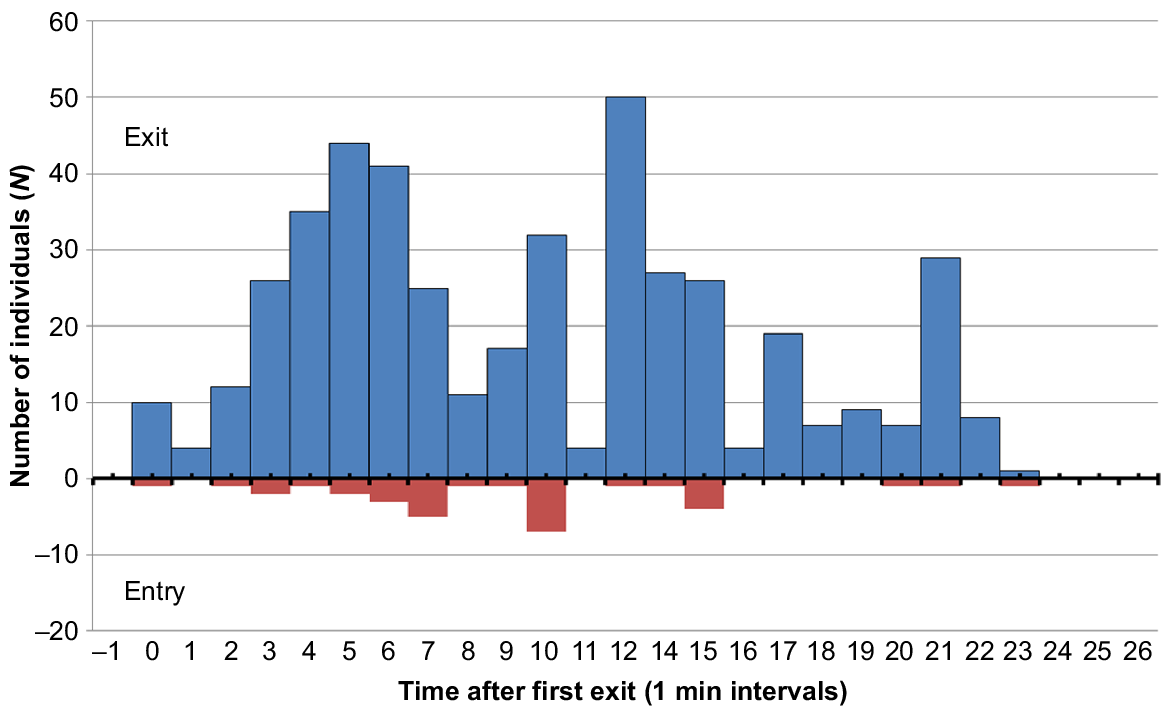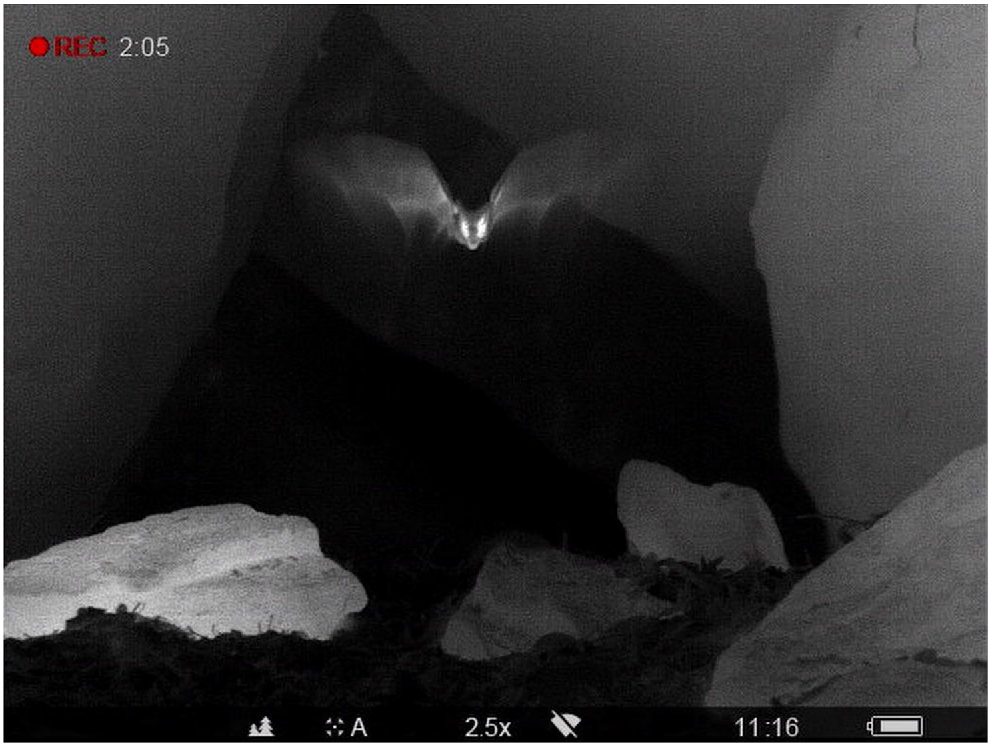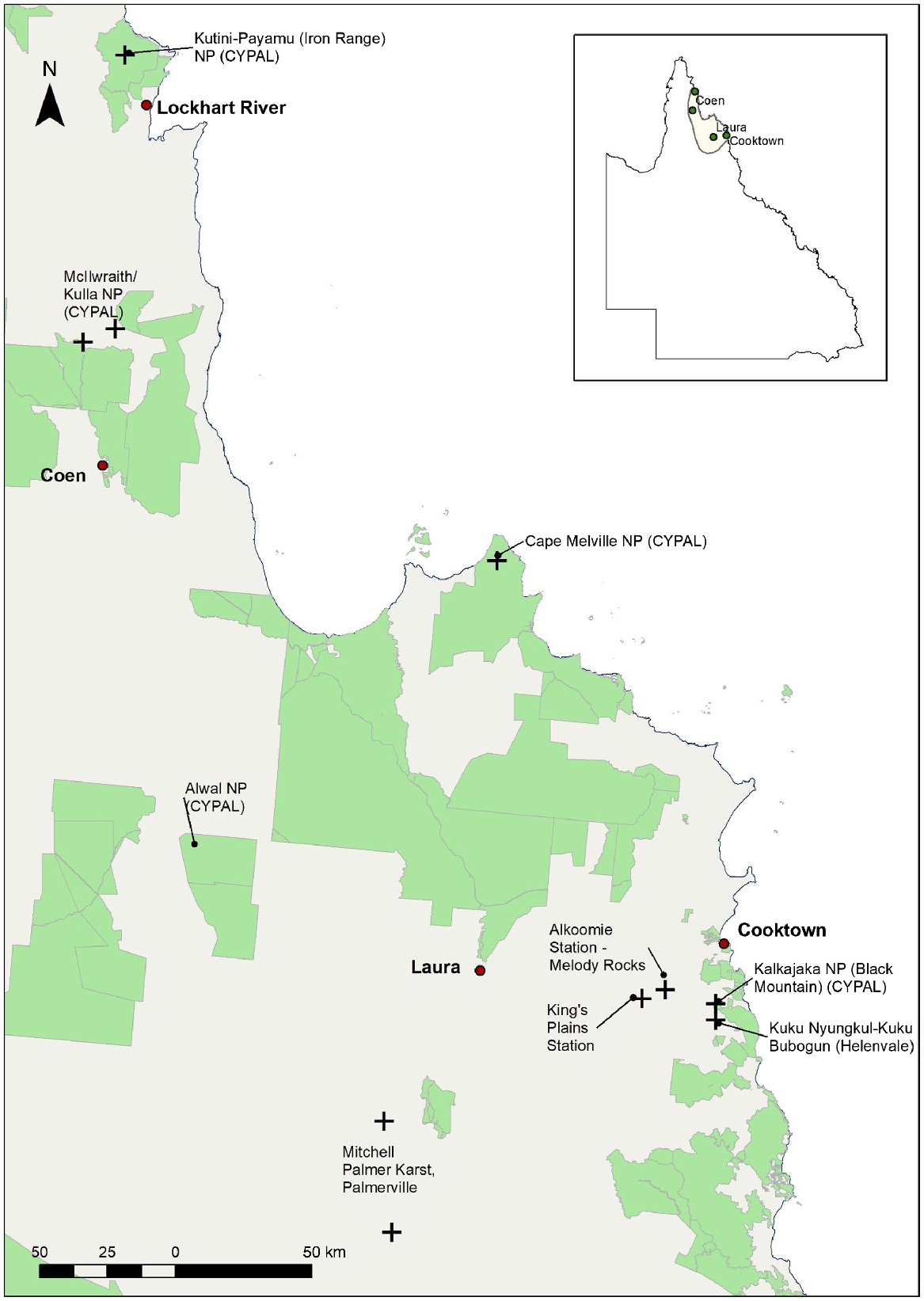A large, newly discovered ghost bat colony in Queensland
John Augusteyn A * , Karl Goetze B and Roger Coles C
A * , Karl Goetze B and Roger Coles C
A Queensland Parks and Wildlife Service, PO Box 3130, Red Hill, Qld 4701, Australia.
B Queensland Parks and Wildlife Service, 83 Main Street, Atherton, Qld 4883, Australia.
C Nanobat Systems, PO Box 1540, Kenmore, Qld 4069, Australia.
Abstract
Obtaining accurate counts that do not cause harm to the animals being studied are important for assessing a species’ conservation status. A single evening exodus of ghost bats (Macroderma gigas) was recorded using a thermal imaging camera placed outside the entrance to a cave on Alwal National Park (CYPAL) in September 2022. At least 463 bats were counted, making it the largest known ghost bat colony in Queensland. Further work is required to determine the extent to which this colony is related to other nearby colonies in Cape York Peninsula. Work is also required to identify and reduce threats to this population and ensure its conservation.
Keywords: abundance, Cape York, disturbance, non-invasive, thermal camera, thermography, threatened species conservation.
Introduction
Several populations of Australia’s largest carnivorous, echolocating bat, the ghost bat (Macroderma gigas), are in decline in Queensland and the species is listed as Endangered under the State’s Nature Conservation Act 1992 and Vulnerable under the Federal Environmental Protection and Biodiversity Conservation Act 1999. Recent estimates suggest that there could be between 680 and 1000 ghost bats remaining in Queensland (Worthington Wilmer et al. 2012; Woinarski et al. 2014; TSSC 2016). Studies have shown that ghost bats have undergone major range contractions in recent years and are restricted to a few, highly disjunct maternity areas (Churchill and Helman 1990; Hand and York 1990; Wilmer et al. 1999). Threats include loss of roosts from mining-related activities and deterioration of disused underground mines, disturbance of roosts, particularly during the breeding and over-wintering period through human visitation, burning and clearing of foraging habitat, barbed-wire fences, susceptibility to cane toad toxin, and potential predation and competition from introduced carnivores (Woinarski et al. 2014; White et al. 2016; Armstrong et al. 2021; Bullen 2021). Survey biologists causing disturbance at critical roosts is considered a threat and ideally non-invasive techniques that do not involve humans entering roost sites when the bats are present, are an important way to limit disturbance (see IUCN Red List: Armstrong et al. 2021). Thermal video cameras have been used non-invasively to monitor bat species that emerge via a restricted number of cave entrances (Sabol and Hudson 1995; Grant et al. 2010). The technology detects infrared energy emitted from an object. Therefore, no additional illumination is required, limiting disturbance to the animals being monitored and allowing the species to be monitored at critical times such as during the over-winter and maternity seasons and at places where the maternity season is unknown. Female ghost bats generally carry their young with them for the first three weeks, after which they are left inside the cave and are vulnerable to being dislodged by other pups or flying adult bats if they are disturbed, which is usually fatal (Toop 1985; Bullen 2021). The timing of parturition varies with latitude (Bullen 2021) and ghost bats in northern latitudes give birth in July–August, whereas birthing occurs between October and December in more southern latitudes (Toop 1985; Augusteyn et al. 2018; Bullen 2021). The timing of birth in Cape York is not well known but may be similar to that in the Northern Territory (July–August) (Churchill 2008; Hanrahan et al. 2021).
In northern Queensland, at the southern end of Cape York Peninsula, estimates suggest there could be up to 170 ghost bats living in karst areas on Kings Plains Station, and 60 in the Mitchell Palmer Karst area (Wilmer et al. 1999). A more recent estimate indicates there could be a further 200 ± 50 individuals in the Kuku Nyungkul–Kuku Bubogun (Black Mountain) area, south of Cooktown (Woinarski et al. 2014; C. Clague, pers. comm.). On Cape York Peninsula, ghost bats have been sighted further north in the McIlwraith Range, Iron Range and near Coen, but no maternity caves are known from these areas (Reardon et al. 2010; WildNet 2022). Incidental sightings have also been recorded from the southern part of Cape York Peninsula including Artemis Station, Cape Melville National Park (CYPAL) and Alwal National Park (CYPAL) (Alwal), but the existence of a maternity cave and the size of the colony in this area was unknown.
Quantitative estimates of ghost bat colony sizes, using non-invasive methods, are required to enable robust assessments of the conservation status of the species. In the absence of this empirical data, assessments are often based on authoritative reviews without any means of verifying colony sizes. The aim of this study was to count the number of ghost bats emerging from a cave located on Alwal and, in doing so, contribute empirical data to the assessment of the species’ conservation status.
Methods
Study area
Alwal is located approximately 180 km north-west of Cooktown and is situated between the Hann and Morehead Rivers. The Park straddles the Great Dividing Range and contains a mix of elevated sandstone escarpment and granitic boulder areas. Several small caves and rock overhangs can be found within these elevated areas. Open eucalypt woodlands dominate the area and a few small springs, surrounded by vine thickets, intersect the site. Sunset at the site on 13 September 2022 was at 18:18 hours. The ghost bat cave at Alwal had a single small entrance (approximately 95 cm wide and 115 cm high) that was located at the base of a sandstone escarpment. Grass and other vegetation grew right up to the entrance and the ghost bats flew close to the ground to exit (Fig. 1). The nearest ghost bat colony is approximately 100 km away in the Mitchell Palmer Karst region (Fig. 2).
Survey method
A Pulsar Helion 2 XP50 thermal video camera, with 480 × 640 pixel resolution was mounted on a tripod placed approximately 8 m away and aimed at the cave entrance. The camera was set up to record after sunset (from the end of civil twilight at ~18:30 hours) and left unattended at the location for 49 min. The cameras’ internal memory was used to record the video.
For video analysis, recordings from the thermal imager memory were downloaded and replayed using editing software (DaVinci Resolve 18). This allowed the video sequences to be reviewed by slowed replay including frame-by-frame where necessary, to precisely count the ghost bats as they departed or entered the cave. Aborted exits were discounted and bats re-entering the cave were counted separately and their numbers removed from the total count. The resolution of the camera was sufficiently high to enable detailed observations of the ghost bats and enabled their accurate identification.
Results
In total, 514 ghost bats were recorded clearly exiting the cave over the recording period and 51 bats were seen to re-enter. This resulted in an estimated colony size of 463 bats (Fig. 3). The first bat left the cave at approximately 18:50 hours and the peak exodus reached 50 bats per minute approximately 13 min into the observation period. The single cave entrance restricted the number of bats exiting together (up to four at a time) although it was noted that pairs were clearly emerging at times. At the end of the recording session when the camera was collected, ghost bats could be heard calling from within the cave, suggesting that not all bats had departed. The emergence captured on camera lasted for 23 min of the total 49-min recording period. During the single-frame analysis, we noticed that some individuals had a slightly increased heat signature ventrally on the abdomen and may have been pregnant or feeding young.
Histogram of the number of ghost bats exiting and entering a cave at Alwal National Park (CYPAL). The counts are organised into 1-min intervals with the blue bar representing the bats exiting the cave and the red bars representing those returning to the cave. The peak emergence ranged from one bat every 1.2–1.4 s and the lowest exodus was one bat every 15 s. Approximately 50% of the count occurred within 10 min of the first bat departing (18:50 hours).

Discussion
This discovery of a large ghost bat colony at Alwal is highly significant and will most likely increase the known abundance in Queensland. However, further genetic work is required to determine the relatedness of the Alwal colony to other nearby colonies in Cape York and establish the population size and geographic distribution of this and other subpopulations in the area. No recent data are available for the other nearest colony to Alwal – the Mitchell-Palmer Karst area and this would be needed before the true size of the southern Cape York population could be confirmed. The colonies around Cooktown including at Kuku Nyungkul–Kuku Bubogun, south of Cooktown and at Kings Plains appear stable, with a recent estimate of 200 bats for the southern Cooktown population (C. Clague, pers. comm.). These colonies should be resampled to determine what proportion, if any, have already been counted/estimated from Alwal and other nearby (within 180 km of Alwal) colonies.
The Alwal colony is now considered the largest in Queensland and is comparable to other large colonies in Australia, including at Pine Creek and Pungalina in the Northern Territory and Bulletin Mine in Western Australia (Woinarski et al. 2014). This site, therefore, most likely represents an important addition to the persistence of the species in Australia and is worthy of protection. Even though this study was opportunistic and based on a single 49-min recording period, it does contribute robust and current data to the assessment of the species’ conservation status. Without such data the accuracy of the assessment process is diminished, and this has led to quite different global population size estimates in the past, where estimates are inferred or not based on empirical data (see review in Woinarski et al. (2014)). The species was both delisted and relisted under Commonwealth legislation, because of population information, with the less than 10 000 individuals threshold being a key contributor to the current listing. This highlights the importance of obtaining accurate data and not relying too heavily on inferred or non-quantitative estimates.
While the count represents a large ghost bat colony, the true size of the colony and population could be much larger. Ghost bats were heard calling from inside the cave when the camera was being retrieved, suggesting that not every bat had vacated the cave and implying the size of this colony was greater than counted. The moon was full at the time of the survey and ghost bats are known to delay their emergence or remain in the cave for a period of about four days either side of this time (G.J. Toop, unpubl. data; Armstrong 2010). Ideally, future counts should be made for much longer and preferably all night to record the re-entry and allow for two estimates per night. The limited storage and battery capacity of the camera used would mean that a second camera would be required to record the entire fly-out and fly-in. However, even within the limits of the thermal imager, the results are compelling for a very large colony.
Thermal cameras have been used successfully to count many cave-dwelling bats, including the ghost bat, emerging from an adit near Pine Creek in the Northern Territory (Grant et al. 2010; K.N. Armstrong, pers. comm., 2015 cited in TSSC (2016)). Although the use of a thermal camera is not novel, the current study did demonstrate the capacity of the technology to capture important data quickly and without disturbing the bats. Ghost bats rely on a limited number of maternity caves and their identity and protection is critical to the survival of the species. The use of non-invasive techniques at maternity caves or where it has not been established if the cave is used for maternity purposes is critical. The increased ventral heat signature observed on some of the bats could indicate pregnancy or potentially parturition if females were feeding young (Cilulko et al. 2013; Cilulko-Dołęga et al. 2018). The potential for the Alwal cave to be a maternity site highlights the importance of using non-invasive techniques when monitoring sensitive species and or at sensitive times or when a cautionary approach is desirable because the maternity season is unknown.
The management of threats to what is likely to be one of Queensland’s most important ghost bat colonies will be crucial to the colony’s ongoing persistence. The size and location of the cave entrance and the vegetation growing adjacent to the entrance likely means that the colony is vulnerable to smoke from fires that potentially burn right up to the entrance. The position of the cave entrance relative to the surrounding ground also means exiting ghost bats would be within easy reach of feral cats and their depredation potentially poses a significant risk to the Alwal colony. Cats have been identified as a threat to other bat species (Oedin et al. 2021) and there is limited evidence that they prey on ghost bats (Bullen 2021). A single feral cat was observed during the survey and a ranger team subsequently shot two cats since the survey (QPWS, unpubl. data). It is recommended that cat stomachs be analysed for evidence of ghost bat predation and, if needed, a cat control program be established.
Overall, the study demonstrated the utility and the efficiency of thermal cameras as a non- invasive technique capable of obtaining empirical counts of ghost bat colonies that live in caves that contain a small number of entrances. The Alwal colony is likely to be important for the long-term persistence of ghost bats in Australia. As a result, it will be important to manage threats and obtain regular, quantitative counts to monitor the population and ensure its conservation.
Data availability
The data that support this study will be shared upon reasonable request to the corresponding author.
Author contributions
John Augusteyn is a senior ecologist within the Queensland Parks and Wildlife Service who was involved with the conceptualisation, project administration, capturing data, and writing and reviewing the original draft. Karl Goetze is a Natural Resource Management ranger who was involved with capturing data and reviewing drafts. Roger Coles is a biologist with extensive experience in developing and using acoustic devices to study the behavioural ecology of bats and was involved in analysing the data and reviewing drafts.
Acknowledgements
We thank the Olkola First Nations people for granting us access to the area. Craig Dickmann is thanked for his assistance during the study. Rhonda Melzer is thanked for her comments on drafts.
References
Armstrong KN (2010) Assessing the short-term effect of minerals exploration drilling on colonies of bats of conservation significance: a case study near Marble Bar, Western Australia. Journal of the Royal Society of Western Australia 93, 165-174 Available at http://www.rswa.org.au/publications/Journal/93(4)/ROY%20SOC%2093.4%20ARMSTRONG%20165-174.pdf.
| Google Scholar |
Armstrong KN, Woinarski JCZ, Hanrahan NM, Burbidge AA (2021) Macroderma gigas (amended version of 2019 assessment). The IUCN Red List of Threatened Species 2021: e.T12590A209530568. Available at https://dx.doi.org/10.2305/IUCN.UK.2021-3.RLTS.T12590A209530568.en [Accessed 31 January 2023]
Augusteyn J, Hughes J, Armstrong G, Real K, Pacioni C (2018) Tracking and tracing central Queensland’s Macroderma – determining the size of the Mount Etna ghost bat population and potential threats. Australian Mammalogy 40(2), 243-253.
| Crossref | Google Scholar |
Churchill SK, Helman PM (1990) Distribution of the ghost bat, Macroderma gigas (Chiroptera: Megadermatidae) in central and south Australia. Australian Mammalogy 13(2), 149-156.
| Crossref | Google Scholar |
Cilulko J, Janiszewski P, Bogdaszewski M, Szczygielska E (2013) Infrared thermal imaging in studies of wild animals. European Journal of Wildlife Research 59, 17-23.
| Crossref | Google Scholar |
Cilulko-Dołęga J, Janiszewski P, Bogdaszewski M (2018) The applicability of thermography during the breeding season and early nursing in farmed fallow deer. International Journal of Applied Research in Veterinary Medicine 16(3), 186-196.
| Google Scholar |
Grant C, Reardon T, Milne D (2010) Ghost bat count at Kohinoor Adit. Australasian Bat Society Newsletter 35, 36-38.
| Google Scholar |
Hand S, York A (1990) Morphological variation in the dentition and skull of the Australian ghost bat, Macroderma gigas (Microchiroptera, Megadermatidae). Australian Journal of Zoology 38(3), 263-286.
| Crossref | Google Scholar |
Hanrahan N, Turbill C, Armstrong KN, Dalziell AH, Welbergen JA (2021) Ghost bats exhibit informative daily and seasonal temporal patterns in the production of social vocalisations. Australian Journal of Zoology 67(6), 305-315.
| Crossref | Google Scholar |
Oedin M, Brescia F, Millon A, Murphy BP, Palmas P, Woinarski JCZ, Vidal E (2021) Cats Felis catus as a threat to bats worldwide: a review of the evidence. Mammal Review 51, 323-337.
| Crossref | Google Scholar |
Sabol BM, Hudson MK (1995) Technique using thermal infrared imaging for estimating populations of gray bats. Journal of Mammalogy 76, 1242-1248.
| Crossref | Google Scholar |
Toop GJ (1985) Habitat requirements, survival strategies and ecology of the ghost bat Macroderma gigas Dobson (Microchiroptera, Megadermatidae) in central coastal Queensland. Macroderma 1, 37-41.
| Google Scholar |
White AW, Morris I, Madani G, Archer M (2016) Are cane toads Rhinella marina impacting ghost bats Macroderma gigas in northern Australia? Australian Zoologist 38(2), 183-191.
| Crossref | Google Scholar |
Wilmer JW, Hall L, Barratt E, Moritz C (1999) Genetic structure and male-mediated gene flow in the ghost bat (Macroderma gigas). Evolution 53, 1582-1591.
| Crossref | Google Scholar |




